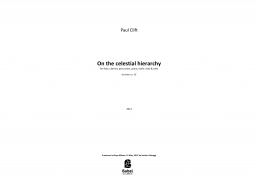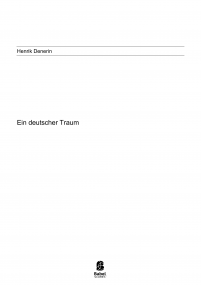Natural Optical Water II
acoustic version with fixed score of Natural Optical Water
11,33 €
Version numérique (+0,00 €) à télécharger
Version papier (+20,30 € impression et livraison ). Colissimo7-14 days aprox.
Chez BabelScores, quand vous achetez une partition, vous pouvez ensuite contacter directement le compositeur ici même !
Caractéristiques
Region
Europe
Estimated Duration
11 - 15min
Date
2015
ISMN : 979-0-2325-3971-3
Notes sur cette pièce Natural Optical Water II
Natural Optical Water II (for piano and ensemble) is the acoustic version, with fixed score, of Natural Optical Water (for piano, ensemble, water samples, optical device and live electronics), commissioned by the Italy Pavilion for Expo Milano 2015.
The piece is in five sections each based on a different class of resonant and echoing texture. Every section has a main leading part (most often the piano part) that acts as a genetic code; it generates all the material through proliferations and delays which affect the temporality, the tuning, the harmonic color and the overall quality of the texture.
Each instrument of the ensemble is tuned to a different frequency (spanning from A = 425 Hz of the flute, to A = 440 Hz of piano and percussions); in some sections, musicians even plays at an individual tempo which is proportional to the tuning. Single instrumental parts are thus similar to independent “organic sound structures” generated by a leading part and cooperating in a larger “sound organism”.
The first section evokes an evanescent and moving liquid surface that ripple when perturbed by sound events; in the second section, the pianist “extracts” the sound from the piano, as from a source, producing a texture of harmonic-glissando on a low D. The texture of harmonics-glissando is echoed and amplified by the bariolages and the harmonic-based figures of the strings and woodwind, where each musician play at a different tempo.
The progressive amplification and ramification of a “bouncing” figure of the piano, resounding in the ensemble, is the core process of the third section. Pitches, durations and rhythm are often proportional or closely connected.
A long and meditative phrase of the clarinet, surrounded by harmonic sounds of the piano, pervades the fourth section. A moment of silence and stillness in the middle of dynamism.
The pianist has to differentiate four layers of sound events in the fifth section. The first layer is a constant “stream” consisting of a pattern based on major thirds, generally played piano. The second to fourth layers consist of incidental pitches which are gradually superimposed to the first layer. These three events act like different sorts of small turbulences and perturbations of the first layer, the “stream”, which reacts as an elastic and echoing texture, as the ensemble does.
Filippo Zapponi
Ajouter à une playlist
- Identifiez-vous pour créer une liste
Natural Optical Water II (for piano and ensemble) is the acoustic version, with fixed score, of Natural Optical Water (for piano, ensemble, water samples, optical device and live electronics), commissioned by the Italy Pavilion for Expo Milano 2015.
The piece is in five sections each based on a different class of resonant and echoing texture. Every section has a main leading part (most often the piano part) that acts as a genetic code; it generates all the material through proliferations and delays which affect the temporality, the tuning, the harmonic color and the overall quality of the texture.
Each instrument of the ensemble is tuned to a different frequency (spanning from A = 425 Hz of the flute, to A = 440 Hz of piano and percussions); in some sections, musicians even plays at an individual tempo which is proportional to the tuning. Single instrumental parts are thus similar to independent “organic sound structures” generated by a leading part and cooperating in a larger “sound organism”.
The first section evokes an evanescent and moving liquid surface that ripple when perturbed by sound events; in the second section, the pianist “extracts” the sound from the piano, as from a source, producing a texture of harmonic-glissando on a low D. The texture of harmonics-glissando is echoed and amplified by the bariolages and the harmonic-based figures of the strings and woodwind, where each musician play at a different tempo.
The progressive amplification and ramification of a “bouncing” figure of the piano, resounding in the ensemble, is the core process of the third section. Pitches, durations and rhythm are often proportional or closely connected.
A long and meditative phrase of the clarinet, surrounded by harmonic sounds of the piano, pervades the fourth section. A moment of silence and stillness in the middle of dynamism.
The pianist has to differentiate four layers of sound events in the fifth section. The first layer is a constant “stream” consisting of a pattern based on major thirds, generally played piano. The second to fourth layers consist of incidental pitches which are gradually superimposed to the first layer. These three events act like different sorts of small turbulences and perturbations of the first layer, the “stream”, which reacts as an elastic and echoing texture, as the ensemble does.
Filippo Zapponi
Instrumentation
Flute|Clarinet|Percussions|Piano|Violin|Viola |Cello
Score Details
Format - A3 / Tabloid
Pages - 62
Pages - 62











